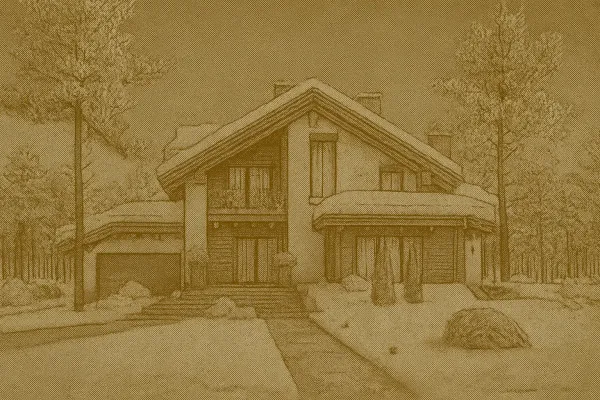Heads up: some of the links in this post are affiliate links. That means if you click and purchase, we may get a commission. It’s how we keep this site running without cluttering it with ads.
Newfoundland and Labrador, a province renowned for its breathtaking coastal beauty, is also famous for its formidable weather. From the relentless, howling winds that sweep across the Atlantic to the driving, horizontal rain and pervasive coastal fog, homes here face a unique and constant challenge. Protecting your property isn't just about comfort; it's about preserving your investment, ensuring safety, and maintaining the structural integrity of your most valuable asset.
This comprehensive guide provides actionable advice specifically tailored for Newfoundland's challenging climate. We'll delve into every critical aspect of weatherproofing, from your roof to your foundation, ensuring your home stands resilient against whatever the North Atlantic throws its way.
Understanding Newfoundland's Climate Challenge
Before we dive into solutions, it's crucial to understand why Newfoundland's weather demands such robust protection. It's not just the quantity of precipitation or the speed of the wind; it's the unique combination and persistence of these elements.
The Unrelenting Wind
- Newfoundland is one of the windiest regions in Canada. Coastal areas, in particular, experience sustained high winds and frequent gusts that can exceed 100 km/h. These winds exert immense pressure on every exterior surface of your home:
- Uplift on roofs: High winds can lift shingles, exposing the underlayment and creating pathways for water.
- Lateral pressure on walls: Constant buffeting can stress siding, windows, and doors, leading to cracks and gaps.
- Wind-driven rain: Rain isn't just falling vertically; it's often driven horizontally, forcing its way into even the smallest openings.
The Persistent Rain and Coastal Fog
- While the wind is a major factor, the sheer volume and nature of precipitation are equally challenging. Newfoundland experiences significant rainfall throughout the year, often accompanied by dense fog that saturates surfaces.
- Moisture penetration: Prolonged exposure to moisture, especially wind-driven rain, can penetrate siding, window seals, and even foundations, leading to rot, mould, and structural damage.
- Freeze-thaw cycles: In colder months, absorbed moisture can freeze and expand, exacerbating cracks and causing materials to degrade faster.
- Salt spray: Coastal homes are also subjected to corrosive salt spray, which can accelerate the deterioration of metal components and certain building materials.
Why Weatherproofing is Non-Negotiable
Ignoring these climatic realities can lead to costly repairs, diminished energy efficiency, and a compromised living environment. Proactive weatherproofing is an investment that pays dividends in peace of mind, reduced utility bills, and a longer lifespan for your home.
The Roof: Your First Line of Defence
Your roof is the primary barrier against the elements. In Newfoundland, it needs to be exceptionally robust.
Shingle Selection and Installation
The right shingles, properly installed, are crucial for resisting wind uplift and shedding water effectively. Standard shingles may not withstand Newfoundland's sustained high winds.
Actionable Advice:
- Heavy-Duty Shingles: Opt for high-wind rated asphalt shingles or architectural laminate shingles with a minimum 40-year warranty. These are heavier and designed with stronger adhesive strips to resist uplift. Consider brands like IKO or GAF, widely available at Canadian building supply centres like Kent Building Supplies or Home Hardware.
- Proper Nailing: Ensure shingles are nailed with six nails per shingle (instead of the standard four) and that nails are driven flush, not overdriven or underdriven. This is critical for wind resistance.
- Synthetic Underlayment: Beneath your shingles, use a synthetic roofing underlayment rather than traditional felt paper. Synthetic underlayment offers superior tear resistance, water repellency, and can withstand exposure to the elements for longer if shingles are damaged.
- Ice and Water Shield: In valleys, around chimneys, and along eaves, install self-adhering ice and water shield. This rubberized asphalt membrane provides an impenetrable barrier against ice damming and wind-driven rain.
Flashing and Sealants
Flashing directs water away from critical junctions on your roof, such as chimneys, vents, and skylights. Improper or degraded flashing is a common source of leaks.
Actionable Advice:
- Inspect Regularly: Annually inspect all flashing for cracks, rust, or signs of separation.
- Proper Flashing Materials: Ensure flashing is made of durable, corrosion-resistant materials like galvanized steel, copper, or aluminum. Step flashing around chimneys and walls should be correctly interwoven with shingle courses.
- Sealant Application: Use a high-quality, UV-resistant roofing sealant around pipe boots, vent bases, and any exposed nail heads. Avoid using too much, as it can trap moisture. For larger gaps or repairs, a flexible flashing tape can provide an excellent temporary or permanent seal.
Gutters and Downspouts
A well-functioning gutter system diverts thousands of litres of water away from your home's foundation, preventing erosion, basement leaks, and damage to siding.
Actionable Advice:
- Regular Cleaning: Clear gutters of leaves, twigs, and debris at least twice a year, especially after autumn and before winter. Clogged gutters can overflow, sending water directly down your walls or pooling around your foundation.
- Proper Pitch: Ensure gutters have a slight pitch (about 1/4 inch per 10 feet) towards the downspouts to allow for efficient drainage.
- Downspout Extensions: Extend downspouts at least 1.5 to 2 metres away from your foundation using flexible downspout extensions or permanent buried drainage pipes.
- Gutter Guards: Consider installing durable gutter guards to minimize debris accumulation, reducing the frequency of cleaning. Look for designs that can withstand high winds without dislodging.
Walls and Siding: Battling Horizontal Rain
Your home's exterior walls are constantly exposed to wind and rain. Choosing the right materials and maintaining them diligently is paramount.
Siding Material Choices
Siding protects the structural components of your walls from moisture and wind. In Newfoundland, it needs to be exceptionally durable and moisture-resistant.
Actionable Advice:
- Fibre Cement Siding: Products like James Hardie fibre cement siding are excellent choices. They are highly resistant to moisture, rot, insects, and fire, and can withstand extreme winds. While more expensive, their longevity and low maintenance often justify the initial cost. Available at most Canadian building supply stores.
- Vinyl Siding: A popular, more budget-friendly option. Ensure you choose a thicker gauge vinyl (e.g., 0.044 inches or more) designed for high-wind areas. Proper installation with adequate fastening and expansion gaps is critical to prevent buckling and blow-offs.
- Wood Siding (with caveats): While aesthetically pleasing, wood siding (like cedar shakes or clapboard) requires significant maintenance in Newfoundland's climate. It must be regularly painted or stained with an exterior wood stain or weather-resistant exterior paint to prevent moisture absorption, rot, and mould.
Sealing Gaps and Cracks
Even the smallest gaps around windows, doors, and where different materials meet can allow wind-driven rain and cold air to penetrate, leading to drafts, moisture damage, and higher heating bills.
Actionable Advice:
- Caulking: Regularly inspect and re-caulk all exterior joints, including around window and door frames, utility penetrations (pipes, wires), and where siding meets trim. Use a high-quality, exterior-grade silicone caulk that remains flexible in extreme temperatures and adheres well to various surfaces. For larger gaps, a backer rod should be used before applying caulk.
- Expanding Foam: For larger voids or penetrations, such as around new window installations or where pipes enter the home, use a low-expansion exterior spray foam sealant. This provides an excellent air and moisture barrier. Ensure it's rated for exterior use and can be painted or covered.
Exterior Paint and Coatings
Paint isn't just for aesthetics; it's a crucial protective layer. A good quality exterior paint acts as a moisture barrier, protecting the underlying materials from water absorption and UV degradation.
Actionable Advice:
- Premium, Breathable Paints: Invest in high-quality, acrylic latex exterior paint specifically designed for harsh weather conditions. Look for paints with mildew resistance and excellent adhesion. Brands like Benjamin Moore or Sherwin-Williams offer robust options.
- Proper Preparation: Before painting, ensure surfaces are clean, dry, and free of loose paint or mildew. Use a high-quality exterior primer on bare wood or previously unpainted surfaces to ensure optimal adhesion and protection.
- Regular Inspection: Check your paint annually for peeling, blistering, or cracking. Address these issues promptly to prevent moisture intrusion.
Windows and Doors: Fortifying Entry Points
Windows and doors are common weak points in a home's thermal envelope and water barrier.
Inspecting and Sealing
Leaky windows and doors are major sources of drafts, heat loss, and water infiltration, especially with wind-driven rain.
Actionable Advice:
- Weatherstripping: Inspect all weatherstripping around doors and operable windows. Replace any cracked, brittle, or missing strips with durable silicone weatherstripping or self-adhesive foam weatherstripping.
- Caulking: As with siding, ensure all exterior caulking around window and door frames is intact and flexible.
- Glazing: Check window panes for loose glazing or cracked putty. Re-glaze as needed to ensure a tight seal between the glass and the frame.
- Door Sweeps and Thresholds: Ensure exterior doors have effective door sweeps and that thresholds are properly sealed to prevent drafts and water from entering at the bottom. A draft stopper for doors can offer an immediate, temporary solution.
Upgrading for Performance
Older, single-pane windows and poorly insulated doors are significant energy drains and offer minimal protection against severe weather.
Actionable Advice:
- Double or Triple-Pane Windows: If budget allows, upgrade to energy-efficient double-pane windows or even triple-pane windows with low-emissivity (Low-E) coatings and inert gas (argon or krypton) fills. These significantly improve insulation and reduce condensation.
- Impact-Resistant Glass: For homes in particularly exposed coastal areas, consider windows with impact-resistant glass, which can better withstand flying debris during severe storms.
- Insulated Doors: Replace old, hollow-core doors with solid, insulated exterior doors made of fibreglass or steel. Ensure they have a good R-value and a tight-fitting frame.
- Window Insulation Film: As a cost-effective interim solution, apply a window insulation film kit to older windows. This creates an insulating air pocket, reducing drafts and heat loss.
Foundation and Basement: Preventing Water Intrusion
Water management around your foundation is critical to prevent basement flooding, mould, and structural damage.
Grading and Drainage
The ground around your home should slope away from the foundation, directing surface water away rather than towards it. Improper grading is a leading cause of basement water issues.
Actionable Advice:
- Positive Grading: Ensure the soil around your foundation slopes away at a minimum of 6 inches over the first 10 feet. Add soil if necessary, using compacted clay or topsoil.
- French Drains: For persistent issues with groundwater or poor soil drainage, consider installing a french drain system around the perimeter of your home. This involves a trench filled with gravel and a perforated pipe to collect and divert water. You'll need landscape fabric to prevent the pipe from clogging.
Sump Pumps and Back-up Systems
Sump pumps are essential for homes with basements or crawl spaces, actively removing groundwater that collects in a sump pit. Power outages during storms can render them useless.
Actionable Advice:
- Regular Checks: Test your sump pump monthly by pouring a bucket of water into the pit to ensure it activates.
- Battery Backup: Invest in a battery backup sump pump system. This is a non-negotiable item for Newfoundland homes, providing crucial protection during power outages.
- Discharge Location: Ensure the sump pump discharge pipe extends well away from your foundation, ideally into a storm drain or a sloped area that directs water away from your property.
Sealing Foundation Cracks
Cracks in your foundation, even hairline ones, can allow water to seep into your basement or crawl space, leading to moisture problems and potential structural compromise.
Actionable Advice:
- Hairline Cracks: For minor, non-structural cracks, a hydraulic cement can be used to seal them from the interior. This material expands as it cures, creating a watertight plug.
- Larger or Active Leaks: For larger cracks or those actively leaking, an epoxy or polyurethane crack injection kit is often the most effective solution. These materials penetrate the crack and bond with the concrete, creating a flexible, watertight seal.
- Professional Assessment: If you notice significant or widening cracks, or if you suspect structural issues, consult a qualified structural engineer or foundation repair specialist.
Ventilation: The Unsung Hero of Weatherproofing
Proper ventilation is often overlooked but is critical for managing moisture within your home, preventing mould, rot, and structural damage.
Attic Ventilation
A well-ventilated attic allows warm, moist air to escape, preventing condensation, mould growth, and the formation of ice dams on your roof in winter.
Actionable Advice:
- Balanced System: Ensure you have a balanced system of soffit vents (intake) and roof vents (exhaust). The goal is continuous airflow.
- Clear Obstructions: Ensure insulation is not blocking soffit vents. Use attic rafter vents to maintain a clear air channel.
- Insulation Levels: While not strictly ventilation, proper attic insulation (R-value of R-50 to R-60 for Newfoundland) works hand-in-hand with ventilation to keep the attic cool and dry.
Crawl Space Ventilation
Unventilated or poorly ventilated crawl spaces are breeding grounds for moisture, mould, mildew, and pests, which can lead to poor indoor air quality and structural damage to floor joists.
Actionable Advice:
- Vapour Barrier: Install a heavy-duty crawl space vapour barrier (6-mil polyethylene or thicker) over the entire crawl space floor and up the foundation walls. This prevents ground moisture from evaporating into the space.
- Dehumidifier: In persistently damp crawl spaces, an energy-efficient crawl space dehumidifier can be invaluable for controlling humidity levels.
- Sealed Vents (in some cases): In very cold climates like Newfoundland, some experts recommend sealing crawl space vents and conditioning the space as part of the home's envelope, especially if a vapour barrier and insulation are in place. Consult a local building professional for advice specific to your home.
Emergency Preparedness and Ongoing Maintenance
Weatherproofing is not a one-time project; it's an ongoing commitment. Being prepared for the worst and maintaining your home regularly will save you stress and money.
Essential Tools and Supplies
Having the right tools and materials on hand allows for quick, temporary repairs during a storm, preventing minor issues from escalating into major damage.
Actionable Advice:
- Emergency Repair Kit: Assemble a kit including heavy-duty tarps, duct tape, roofing cement, a utility knife, and a caulking gun with extra tubes of sealant.
- Portable Generator: Given the frequency of power outages, a reliable portable generator is a wise investment to power essential appliances like your furnace, refrigerator, and sump pump. Ensure you have a safe, well-ventilated location for operation.
- Safety Gear: Always have work gloves, safety glasses, and a sturdy ladder for inspections and repairs.
Annual Inspection Checklist
Proactive inspections allow you to identify and address potential vulnerabilities before they become costly problems.
Actionable Advice:
- Spring/Fall Walk-Through: Conduct a thorough inspection of your home's exterior every spring and fall.
- Roof: Look for missing, cracked, or curled shingles. Check flashing around chimneys and vents.
- Gutters: Ensure they are clear and properly attached.
- Siding: Inspect for cracks, loose panels, or signs of moisture damage.
- Windows and Doors: Check caulking, weatherstripping, and glazing.
- Foundation: Look for cracks, signs of water pooling, or efflorescence (white mineral deposits).
- Trees: Trim branches that are too close to your roof or could fall on your home during high winds.
Conclusion: Your Resilient Newfoundland Home
Protecting your home from Newfoundland's relentless wind and rain is a critical aspect of homeownership in this beautiful, yet challenging, province. By systematically addressing your roof, walls, windows, doors, and foundation, and by committing to regular maintenance and preparedness, you can significantly enhance your home's resilience.
This guide provides the detailed, actionable advice you need to fortify your property. Remember, investing in quality materials and proper installation now will save you from costly repairs and headaches down the line. Take these steps, and your Newfoundland home will stand strong, warm, and dry, ready to weather any storm for years to come.








